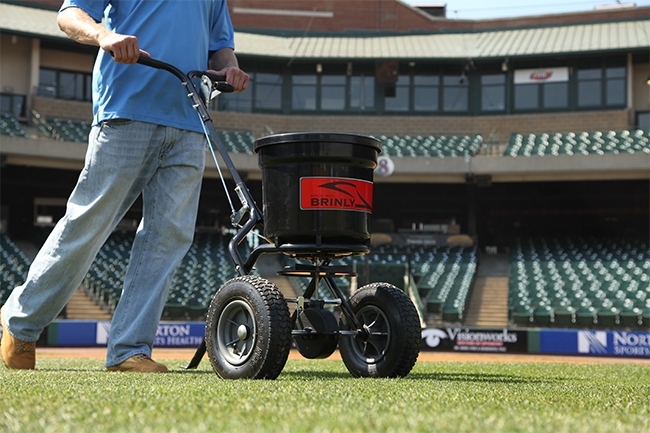You know what they say; you get what you pay for. This is especially true when it comes to spreading lawn fertilizer and other granular chemicals. A mountain of plastic walk-behind spreaders are shipped in from Asia every year, used and discarded, only to be replaced the following year.
For between $40 and $80, these mass-produced broadcast spreaders enable homeowners to apply fertilizer and weed control agents to nourish and protect their lawns. For many, these inexpensive alternatives may be adequate. But every year, thousands of discerning homeowners decide that they’re tired of fighting with their entry-level broadcast spreaders. Instead of replacing their inexpensive spreader every year and dealing with all the headaches that go along with them, they’d rather upgrade to a superior quality spreader and reap the benefits:
Fewer Refills
The whole premise of using a walk-behind spreader is to apply materials more evenly and more efficiently. Every time you have to refill the hopper, not only does it slow down the application process, but the stopping and starting creates inconsistencies in material coverage.
Evenly Balanced Spread Pattern
When it comes to fertilizer application especially, consistency is the name of the game. We’ve all seen those light and dark streaks in our neighbors’ lawns (or maybe our own). Walk-behind spreaders are wheel driven, which means that the traction the wheels generate translates into the rotational force driving the spinner. Slick, hard plastic wheels will slide and skid across the surface of the lawn, causing the spinner to rotate at varying speeds. A high quality spreader will have large, air-filled rubber tires so that they can get a solid grip on the lawn’s surface and drive the spinner at a consistent speed.
Easier to Push
The other upside of having large wheels is that they make the spreader much easier to push, especially through tall grass and over uneven soil. Have you ever tried riding a skateboard on a sidewalk with uneven sections? Ouch. Ride a bicycle down the same sidewalk–no big deal. Bigger wheels make all the difference.
No Cables
Instead of using spring-loaded cables and a trigger mechanism to hold the rate gate open, a good spreader will have a solid metal linkage between the on-off lever and the rate gate hardware. That way, you don’t wear out your forearm by struggling to keep the gate open the whole time. Also, especially under constant tension, cables are prone to breakage. A solid linkage that isn’t under constant tension will last season after season, and won’t make your forearm feel like you’ve been rock climbing all day.
Replacement Parts
In the event that you do have a breakage, many bare-bones spreaders are not designed to be repairable. This is what’s called planned obsolescence, designing a product with the intent that it will need to be replaced more frequently in order to increase profits. However, manufacturers of high quality spreaders will stand behind their product by making replacement parts available so you can inexpensively replace only the affected part without having to discard the entire product. All Brinly repair parts are available at Shop.Brinly.com 24 hours a day, 7 days a week.
Metal Frame & Axle
Ultimately, the biggest difference of a superior spreader is the quality of the construction. Load-bearing and rotating parts need to be made of metal; there’s really no way around it. If you’re going to load 25 or 50 pounds of corrosive chemicals into a hopper and bump and bounce it all around a lawn, it needs to be built like a tool, not like a toy.
Click here for more information on the superior spreader: Brinly’s P20-500BH

Author: Brad Turner



